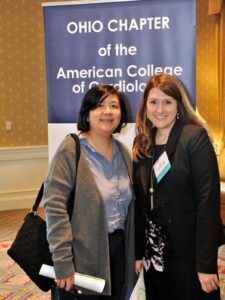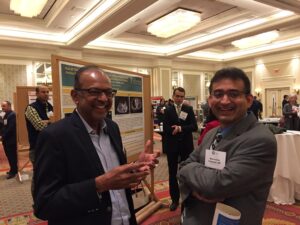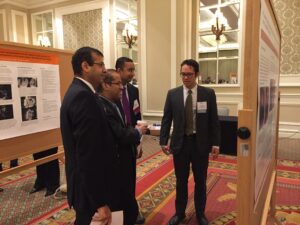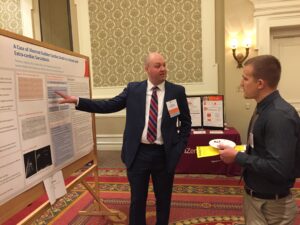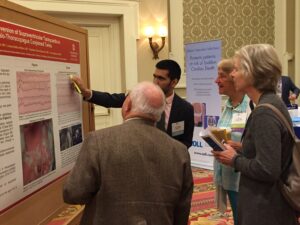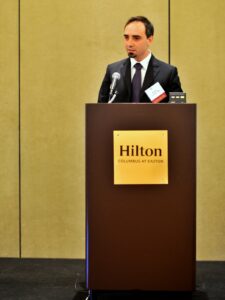Ohio-ACC 26th Annual Meeting & 5th Annual Richard Lewis Memorial Lecture
October 15, 2016 | Hilton Columbus at Easton, Columbus, OH
Meeting Brochure | Syllabus/Disclosures
Photos
Special thanks to Dr. Robert Mosteller for his excellent photography!
Agenda
Friday, October 14
12:00 noon – 2:00 p.m. – MACRA Round Table – Please invite your cardiovascular administrator to join you, and register via the “Register” link.
MACRA Readiness: Top 10 Things You Need to Know, How to Get Your Practice & Service Line Ready, Understanding How the New Mandatory Episodes Integrate with MACRA
Cathleen Biga, RN, MSN and Kelly J. Scheiderer, RHIA, MHA
handout
Saturday, October 15
7:00-7:55 a.m.
Registration, Exhibits, Posters, and Continental Breakfast
7:55-8:00 a.m.
Welcoming Remarks
Laxmi S. Mehta, MD, FACC
8:00-8:50 a.m.
MI and the Older Adult: Changing Demography and Impact on Care
Joseph S. Alpert, MD, FACC
handout
8:50-9:40 a.m.
Peripheral Arterial Disease in 2016 and Beyond: Walk this Way
Gary M. Ansel, MD, FACC
handout
9:40-10:25 a.m.
Break, Exhibits, Poster Competition
10:25-11:10 a.m.
Gene Therapies for CAD and HF: Can We Reverse the Failing Heart?
Marc Steven Penn, MD, PhD, FACC
11:10 a.m. -12:00 p.m.
Navigating the New Health Care Horizon: Out with SGR, in with MIPS – What You Need to Know
Cathleen Biga, RN, MSN and Mary Norine Walsh, MD, FACC
Biga handout | Walsh handout
12:00-12:45 p.m.
Lunch Break, Exhibits, Posters
Networking Round Tables: Look for a table that interests you!
12:45-1:45 p.m.
5th Annual Richard P. Lewis Memorial Lecture
Geriatric Cardiology: Octogenarian Pearls
Nanette K. Wenger, MD, MACC
handout
1:45-2:15 p.m.
Fellows-in-Training Oral Competition
T-Wave Abnormalities as ECG Signature of Myocardial Edema in NST-Elevation Acute Coronary Syndromes
Andrea Cardona, MD abstract – 2nd place winner
Three Dimensional (3D) Printing and Functional Assessment of Aortic Stenosis Using a Flow Circuit: Feasibility and Reproducibility
Serge Harb, MD abstract – 1st place winner
2:15-3:00 p.m.
FFR and CTA: When Evaluating Anatomy Isn’t Enough
Subha Raman, MD, FACC
handout
3:00-3:15 p.m.
Announcement of Poster Winners and Oral Competition Winners
Posters
Poster Winners
Fellow in Training Oral Presentation
First place – Serge Harb, MD, CCF
Second place – Andrea Cardona, MD, OSUMC
Fellow in Training Clinical Research Posters
First place – Tarek Alsaied , MD, CCHMC
Second place – Bishnu Dhakal, MD, UH
Fellow in Training Case Report Poster Winners
1st year – Samuel Hayes, MD, OSU
2nd year – Tamika Rozema, MD, Rainbow Babies & Children’s Hospital
3rd year/advanced fellowship – M. Rizwan Afzal, MD, OSUMC
CV Team Members (RN, NP, CNS, PA, PharmD) Case Report Poster Winner
First place – Shirlien Metersky, MSN, CNP, CCRN-CMC, OhioHealth
Resident Case Report Poster Winner
First place – Jonathan Pollock, WSU
CME/CNE
Physicians
This activity has been planned and implemented in accordance with the accreditation requirements and policies of the Accreditation Council for Continuing Medical Education (ACCME) through the joint providership of the American College of Cardiology Foundation and Ohio Chapter of the American College of Cardiology. The American College of Cardiology Foundation is accredited by the ACCME to provide continuing medical education for physicians.
The ACCF designates this live educational activity for a maximum of 7.25 AMA PRA Category 1 Credit(s)™. Physicians should only claim credits commensurate with the extent of their participation in the activity.
Nurses
American College of Cardiology Foundation is accredited as a provider of continuing nursing education by the American Nurses Credentialing Center’s Commission on Accreditation.
The ACCF designates this live educational activity for a maximum of 7.25 continuing education hours. Each attendee should only claim credits commensurate with the extent of their participation in the activity.
While offering credits noted above, the course is not intended to provide extensive training or certification in this field.
ATTENTION Nurses who are in need of Category A credit, please visit: http://www.netce.com/3271/Catalog_OH14.pdf. Take a look at the Ohio Nurse Practice Act module on pages 3-11 and then scroll to page 91.
Statement of Need
Cardiovascular disease is the leading health care problem throughout the world. In the United States alone, an estimated 70 million people have been diagnosed with one or more forms of cardiovascular disease (CV), and over 910,000 Americans die from CV disease each year. The cardiac care team is increasingly asked to develop systems of care, the methods for which are not necessarily part of the traditional medical training. We are asked to do this better, faster, more efficiently and at a lower cost.
Overall Goal
The overall goal of this activity is to increase learner competence by discovering strategies to anticipate research-driven changes in practice, to enhance professional growth, and to demonstrate efficacy in team based patient care practice as new clinical approaches and technologies change. The Ohio Chapter-ACC Annual Meeting will include education that provides needs-based learning covering a thorough overview of peripheral arterial disease, imaging, gene therapies for CAD & HF, legislative issues, and geriatric cardiology.
Learner Objectives
Upon completion of this program, participants should be able to:
• Discuss tools and regulations that impact the practice environment and highlight the crucial role that ACC plays in shaping the practice environment.
• Recognize important geriatric syndromes and challenges commonly seen in cardiovascular patients, including atrial fibrillation, heart failure with normal systolic function, isolated systolic hypertension, falls, incontinence, polypharmacy, multimorbidity, delirium and dementia, and learn multidisciplinary management strategies.
• Analyze how Personalized Medicine will change the way cardiovascular practitioners will practice medicine in the future.
• Discuss the appropriate selection and use of cardiac imaging in patients with cardiac disease.
• Review the evidence behind the medical treatment of PAD, such as antiplatelet therapies, ACE I, beta blockers, and statins.
Target Audience
Adult Cardiologists, Pediatric Cardiologists, Cardiothoracic Surgeons, Cardiology Fellows-in-Training, Nurses, Nurse Practitioners, Clinical Nurse Specialists, Physician Assistants, Pharmacists
Disclosure Policy
As a provider accredited by the Accreditation Council for Continuing Medical Education (ACCME) and the American Nurses Credentialing Center (ANCC), the American College of Cardiology Foundation (ACCF) must ensure balance, independence, objectivity and scientific rigor in all of their directly provided or jointly provided/co-provided educational activities. Planners, presenters, and other contributors, in a position to control the content are required to disclose to the audience all relevant financial relationships he/she and/or his/her spouse or domestic partner may have, occurring within the past 12 months, with any entity producing, marketing, re-selling, or distributing health care goods or services consumed by, or used on, patients. When an unlabeled use of a commercial product or an investigational use not yet approved for any purpose is discussed during an educational activity, the contributor should disclose that the product is not labeled for the use under discussion or that the product is still investigational.
ACCF is committed to providing its learners with high-quality activities and materials that promote improvements and quality in health care and not a specific proprietary business or commercial interest. The intent of this disclosure is not to prevent participation in educational activities by persons with a financial or other relationship, but rather to provide learners with information on which they can make their own determination whether financial interests or relationships may influence the education activity.
ACCF assesses conflicts of interest (COI) with its faculty, planners, managers, staff and other individuals who are in a position to control the content of CME/CNE activities. All relevant potential conflicts of interest that are identified are thoroughly vetted through a process that includes course directors and appropriate peer review by education committee chairs/members, for fair balance, scientific objectivity and validity, and patient care and safety recommendations.

